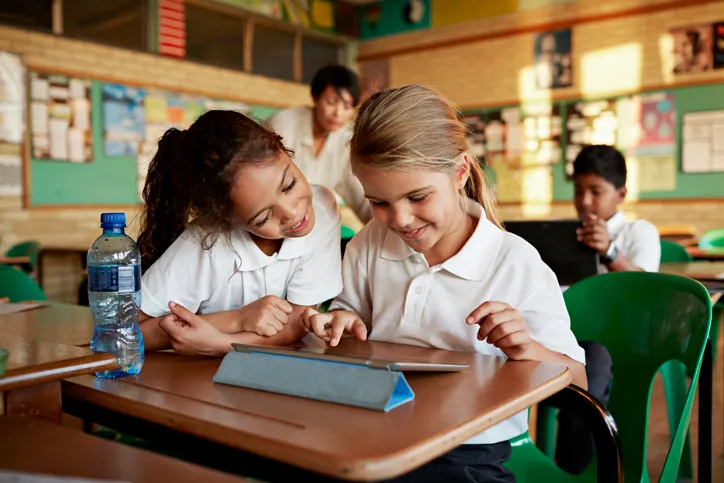From blackboards to wearable technology, education has seen rapid changes in the past 50 years. What does the future hold for the next generation of learners?

The journey of education
In 1801, Scottish headmaster James Pillans hung a large piece of slate in his classroom inventing the first blackboard and resolving the sticky issue of communal learning for 19th century students. A new revolution teeters on the horizon as educators look to modern forms of education technology (edtech) to enhance the learning experience.
Edtech that we can expect to see in future classrooms includes generative AI, virtual reality, social media and adaptive learning platforms. Technology has the capacity to enrich lessons and teaching methods. Students will also benefit from greater engagement, the wealth of a learning community and lessons that are adapted to their learning style and ability.
We look at key pieces of edtech that will be as commonplace as pen and paper for the next generation.

Generative AI: information station
OpenAI software, such as ChatGPT, is “going to be huge and transformative” says Dr Sam Illingworth, Associate Professor in Teaching and Learning at Edinburgh Napier University.
Sam’s enthusiasm for the application of generative AI in the education sector is clear despite what he calls the “hyperbolic narrative” around ChatGPT in particular. Will ChatGPT encourage cheating in students? “Students aren’t using it to cheat,” says Sam, “and you can tell when they are”.
What they are using it for, he has discovered, is as an important tool in their research armoury. And to resolve issues when lecturers are out of office. “Students say they are using it to talk to someone outside of normal hours,” says Sam. “It’s not practical to assume that lecturers are going to operate at the same time as students. Generative AI trained with that student will be able to give a response.”
In addition, ChatGPT teaches students to become adept critical thinkers. “It’s a great way to show students how they can use their skills and knowledge to question and develop their own responses to this tool. Our students are going to have to use generative AI when they leave university,” he continues, “so why not teach them that process.”
For the educators, generative AI can help save time on administration, aid with assessment and help develop individualised learning paths for students.
“For all classrooms, educators and students, AI is like Pandora’s box,” says Sam. “It’s been opened. It is here and it’s going to be a huge part of our future.”

Reality, but virtual
Modern pedagogical environments have already adopted virtual reality as part of the teaching toolbox. Fun, holistic and immersive, the opportunities for increased engagement using virtual reality are proven, says a report published in the Educational Research Review entitled, Effects of Virtual Reality on learning outcomes in K-6 Education. The results indicate that, “VR promotes greater student learning in comparison to control conditions… this effect is even greater when immersive VR is used compared to semi-immersive and non-immersive systems”.
School trips once meant a visit to the local museum with a packed lunch. Now students can take a guided tour around the solar system with Titans of Space, or dive alongside sharks with Discovery VR. As VR technology develops and becomes more financially accessible, students can expect to enjoy VR field trips to remote corners of the Earth, inside the human body and indeed around the universe.
Augmented reality also looks set to feature in future learning environments. Interactivity will increase as technology allows for greater sync capability. Wearable smart devices loaded with augmentation apps that can respond to ‘markers’ will provide an in-depth interactive examination of topics, particularly in STEM subjects.

Learning, just for you
While adaptive learning is far from a new concept in the classroom, future education promises to engage technology to further the benefits of providing bespoke tuition. Data analysis will drive adaptive learning technology and provide instant feedback, individually led tutoring and resources to support students as and when they need it.
“Early attempts at adaptive learning worked only for very specific content and curricula,” said Shantanu Sinha, head of Google Education. “With recent AI advances in language models and video understanding, we can now apply adaptive learning technology to almost any type of class assignment or lesson at an unprecedented scale.”
Future adaptive learning systems will work by using data analysis to create a unique learning path for the student. By understanding a student’s strengths, weaknesses, and preferences the software will adapt the speed and style of delivery.
For the educators, data-driven adaptive learning platforms will help them develop students’ personalised learning plans, and provide the information needed to create targeted interventions, as well as allocate resources.

A social experience
Digital education company FutureLearn revealed in its 2022 Future of Learning report that 37 percent of Generation Z (born between 1997 and 2015) use Instagram to top up traditional education and learning, while 24 per cent use X.
Social media is a powerful learning tool by virtue of the community it creates. It has gifted the current generation of learners the ability to discuss concepts and stay engaged alongside peers. It’s also financially very achievable, allowing the digitally disadvantaged access to education.
“It’s going to continue to have a huge influence,” says Dr Sam Illingworth. “It’s a great collaborative learning tool.” While the dangers of social media, particularly for young students is says Sam, “well documented”, the benefits are clear.

The future is bright
Dr Sam Illingworth is excited about the role of technology in the future of the education sector. Technology, he says, “is irrevocably the great leveller of education” albeit with the caveat that open dialogue is necessary to ensure that technology serves all communities equitably. “We need to have clear conversations between the government, HE, policy makers and OpenAI companies.”
Mike Zeally, MD of KPMG Learning Services says in Future Learn’s Future of Learning report that during Covid technology facilitated a well-needed transformation away from traditional teaching methods. “Virtual education delivery is here to stay,” he says. “I think it necessitated a redesign of lots of fairly old, clunky learning, which is probably long overdue. It creates new opportunities and ways to engage with learners.”

